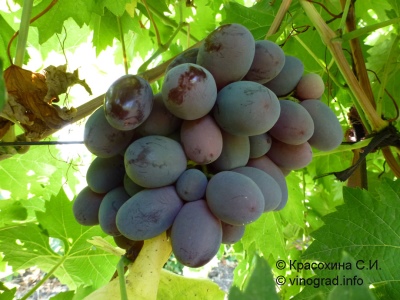
- Authors: Krainov Viktor Nikolaevich
- Appointment: dining room
- Berry color: red-purple
- Taste: harmonious
- Ripening period: average
- Ripening period, days: 125-135
- Frost resistance, ° C: -23
- Bunch weight, g: 600-1000
- Flower type: bisexual
- Density of the bunch: medium
The hybrid vigorous variety Favor appeared not so long ago, but has already become popular among many gardeners. It is eaten fresh, and delicious homemade compotes are also prepared. The grapes are not too whimsical to care for and gives a stable harvest.
Breeding history
An unprofessional breeder VN Krainov, a resident of Novocherkassk, has developed a new variety with great potential. As a result of many years of work, he managed to create an interesting hybrid form using the varieties Talisman and Radiant raisins.
Description
Table grapes have not only an attractive appearance, but also decent taste.
Ripening period
The harvest ripens in about 125-135 days, the ripening period is average. The grapes ripen in mid-September.
Bunches
The bunches have a conical shape, average density and weight of about 600-1000 g. They have a marketable, appetizing and elegant look. One of the advantages of the variety is the absence of a bunch of peas.
Berries
Large fruits are reddish-purple, with medium-dense pulp and oval or elongated-oval shape. They weigh on average about 12-14 g, have a size of 32-30x26-24 mm. The berries are transportable, do not crack during transportation, do not become wrinkled and retain an elegant appearance.
The grapes are consumed fresh, and you can also prepare a variety of dishes, desserts and homemade compotes from it.
Taste
Pleasant, harmonious and moderately sweet.
Yield
The variety gives large, stable yields. The shoots ripen well, the fruiting factor is 1.3. If you follow the basic rules of agricultural technology, one bush can produce about 5-6 kg of fruit per season.


Growing features
Growing a variety is extremely simple, you just need to remember some rules.
Landing
It is necessary to plant a culture in a well-lit, slightly elevated area, in which there are no cold sharp gusts of wind and drafts. It is best to choose a place with loose and nutritious soil with medium to low salinity. It is recommended to install a support made of wood or trellis near the culture, which will allow the grape vine to hold and creep.

Pollination
Favor has bisexual flowers, so it does not need pollinating varieties next to it.
Pruning
Since grapes are fast growing, they should be pruned regularly, that is, the shoots should be shortened. Crops older than 3 years are pruned. In June, the top of the shoots is cut off. Only 5 eyes should be left after the second bunch.In autumn, the shoots should be shortened to the first leaves.

Watering
Water the crop abundantly, but not too often. And also it is worth focusing on climatic conditions and what the soil is. If the topsoil dries out by 2-3 cm, then the grapes should be watered. In the spring, irrigation is carried out (after the opening of the grapes and 7 days before the flowering period).
In the summer, the crop must be watered regularly, once a week. It is not necessary to irrigate the grapes during flowering, as this causes the flowers to crumble.


Top dressing
It is necessary to feed the grapes along with watering. Superphosphates, ammonium sulfate or saltpeter are added to the water for irrigation. Organic fertilizers should be introduced in the spring, after planting grape seedlings or opening bushes.
Frost resistance and the need for shelter
The bushes are able to withstand temperatures of -23 degrees. The grapes are quite resistant to frost and unfavorable climatic conditions. In order not to harm the culture, you should cover the bushes for the winter.

Diseases and pests
The variety is resistant to fungal diseases, sometimes wasps can infect it. It is better to process Tabor regularly to protect it from various kinds of diseases and insects. Especially terrible ailments for this variety are powdery mildew, gray rot, anthracnose and mildew. It is important to process the leaves and mulch the plant on time, as well as loosen the soil, get rid of weeds, and follow the rules of feeding and watering.

If a grape is exposed to any disease or insect, this always affects its appearance.
Storage
The bunches can be stored for a long time under normal conditions (about 3-4 months). In refrigerated chambers, fruits can be stored for much longer.











































































